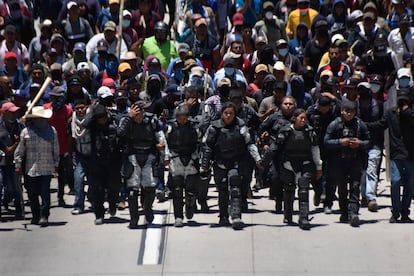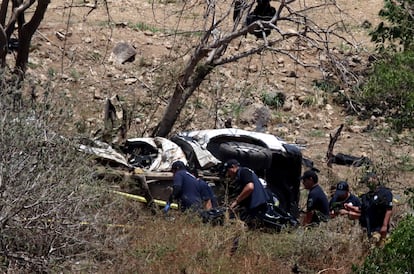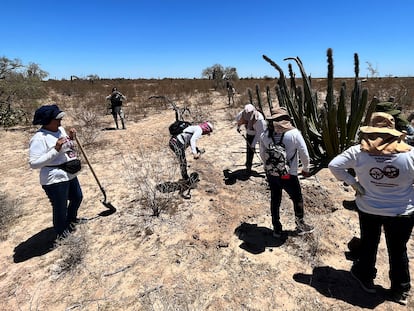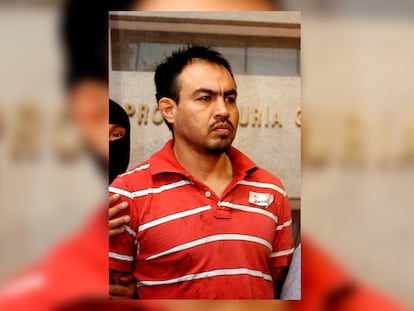In Mexico, organized crime flexes social muscle among the poorest ahead of elections
The drug lords have the power to bring thousands of people to the streets and force the State to negotiate their demands. Experts are already talking about the risk of a full-blown “narco-state”


The drugs industry has turned Mexico into a quicksand hole where the country has been sinking without remedy for the last six years. With its head barely out of the ground, it needs an outstretched hand to avoid succumbing to a criminal power that has diversified its business into any sphere where money flows, from north to south, from east to west. In the last few weeks, counting the victims has been a Sisyphean task: while the fire in a market in the center of the country was being extinguished, bombs were exploding in Jalisco; in Nuevo Leon, a firing squad left six corpses against the wall, the judges of Colima were sheltering in their homes and Guerrero, one of the states where the sand is already up to people’s necks, was ablaze with murdered cab drivers and blocked highways. In this territory, three days of blood and fire brought the authorities to their knees and left an unprecedented image that demonstrates the power of crime to reinvent itself: with a snap of their fingers, this week they mobilized thousands of citizens who marched down the highway to the heart of the state government, scared off the police, stole an armored vehicle, took a dozen agents and workers hostage, and forced the politicians to negotiate their demands. Such a display of social muscle among the poorest rural communities has the country still in awe.
The narco has not only multiplied its business activities, from avocados to the fishing and lumber industry, tourism, cabs, counterfeit products, poultry, beer and water distribution; it is also testing new weapons, from bombs to drones; and its infiltration in the political sphere is no longer limited to pressuring elected officials: it has placed its own people at the head of city councils. It is what is often described as a narco-state. At the beginning of the century, cocaine was the most powerful division of the business, and still today, whether it is fentanyl or anything else, drugs continue to be the main source of profitability. The so-called cobro de piso, that is, the extortion of anyone who sets up a store, sets up a street stall or rides in a wheelchair selling loose cigarettes, is the second most profitable business, the main one in some regions, says Eduardo Guerrero, a security consultant and one of the great experts in this field. Fuel theft has been somewhat reduced with this administration, but they have sought new revenue streams, such as the smuggling of migrants and the trafficking of women, which explains the many disappearances of young people in tourist resorts. And last but not least, there is illegal logging and illegal fishing of marine species that find a good market in Asia,” sometimes in exchange for fentanyl, says Guerrero, who is also director of Lantia Intelligence.

At the local level, in some areas they have taken over the construction business, cement, bricks, and food sectors: they force people to buy chickens or tortillas from their own suppliers. The counterfeiting and sale of all kinds of brand-name products, from watches to mattresses, is another of their strong points. As Luis Astorga, PhD in Sociology and one of the great experts on Mexican criminal networks, recently told this newspaper, you would have to buy a fishing rod and sit patiently on the seashore to be sure that what you put in your mouth has not fattened the coffers of crime. To say narco is to come up short, or perhaps it means everything already.
In May 2008, after the arrest, months earlier, of one of the big kingpins, Alfredo Beltrán Leyva, the war was unleashed. He was not going to be the only one. Where previously three or four criminal leaders were arrested per six-year term, during the government of Felipe Calderón there were almost 40. With each blow to the top, the gangs splintered into smaller factions that spread across the country, each in pursuit of their business. The large northern cartels, violent and focused on drug trafficking to the United States, are now a hydra with a thousand heads, a huge family tree of fathers, brothers and associates who are taking over each territory. There are no longer only lords of the skies or of the subterranean between borders. What emerged as a phenomenon concentrated in the big cities is now national and with a broad impact in rural areas. The harassment of agricultural, livestock and mining companies during the Peña Nieto administration (2012-2018) gave rise to self-defense groups, a civilian population that armed itself to resist criminal attacks. But the narco is all-consuming and today it is no longer clear whether or not these small platoons are under the control of organized crime. One of the most famous vigilantes, Hipólito Mora, who was under great threat, was gunned down in Michoacán at the end of June. Twenty-five gunmen fired more than 1,000 bullets at the target.
But the drug traffickers have always been in the sierras and mountains, those were their places of cultivation and the paths of passage. “They invested money in rural communities to guard the drug trafficking routes and the houses where they kept weapons, money or even kidnapped people, such as migrants,” says Guerrero. Recently, there have been more gestures. In the middle of the pandemic, the distribution of food and household appliances to alleviate the needs of an extremely poor population weary of waiting for a State that never shows up was reported in several parts of the country. “There were even cases in which they offered jobs to young people who had lost their jobs due to the coronavirus crisis,” recalls the security consultant. Crime was buying empathy, solidarity and loyalty. And the common people responded by warning them of the army’s movements in those lands. “The gangs are benevolent with these populations, they need them, they are strategic,” says Guerrero, who compares Mexico’s situation to quicksand where the country is sinking deeper and deeper. The “searching mothers,” who comb the territory in search of the remains of their relatives, are now reaching agreements with the drug traffickers to dig without being attacked, while the State does not always respond to their requests.
From time to time, criminal gangs broadcast videos that look like military parades, with tanks, guns and uniformed men. It’s their way of saying they own this or that territory. The show of force in Chilpancingo, the capital of Guerrero, brought together thousands of peasants and truckers who came down from the mountains armed with stakes and machetes and blocked the highways leading to Acapulco and Mexico City until they had their way. TThe issue suggests a new transformation of crime, with the ability to mobilize entire villages, like a political party that ferries citizens to fill its rallies. “It’s painful, with a leftist government in power whose priority should be to weaken criminal recruitment centers through social programs,” Guerrero laments.

This has been, in fact, the message that President Andrés Manuel López Obrador has launched throughout his term, which he summed up in the phrase “hugs, not bullets.” It is a matter, the president always says, of strangling poverty, of multiplying scholarships and social assistance so that young people do not consider the alternative of crime as an advantageous way out. But one only had to look at the rough sandals and dusty feet, the faces wrinkled by the sun, the jagged teeth of many of the peasants who came with their bamboo clubs to the capital of Guerrero. Poverty is far from being extinguished. And while they were at it, the leaders of the demonstration camouflaged their demands, which the government summarized as the release of two detained mobsters, with a list of social improvements in their communities: sewage drainage, paved streets, educational improvements and road security. No one doubts that this is also needed. But the absence of the State has been giving way to the narco, little by little, election after election.
The elections of 2024 are already on the horizon, when municipal presidents, governorships, congressmembers and senators, and a new president for Mexico will be elected. This imminence also has to do with the outburst of fire that is being experienced in recent days: crime is taking positions, placing its own, pressuring others, playing at destabilization. “Social mobilization, the muscle they have flexed these days, is a message to the political class,” says Lilian Chapa Koloffon, senior analyst at World Justice Project. “They behave like political operators, what they are saying is not only that they can place their own people, but also mobilize voters or destabilize elections. Stealing an armored vehicle and taking hostages at the gates of the Government Palace in Chilpancingo is a huge display of disrespect for the authorities without any fear of sanctions. Authorities have sat down to negotiate with the detained agents for one night,” says Chapa Koloffon. The narco is the interlocutor and every new governor who comes to power feels the narco’s breath on his neck.
“I feel strongly that Mexico will not be able to get out of this alone. We need the cooperation of other countries, a great security treaty for North America, with the United States and Canada, no more ridiculous little programs, standardization of laws and, of course, progress in new technologies for security and training of human resources. That could come together in 10 or 15 years,” says Guerrero, “but society has to push hard on that idea.” In his opinion, the collaboration agreements should be extended to Spain and Italy on the European side, and to Chile and Colombia in the Latin American region. “If they don’t do so already, the risk of the rise of crime to state governments and a de facto Narco-State is certain.”
Sign up for our weekly newsletter to get more English-language news coverage from EL PAÍS USA Edition
Tu suscripción se está usando en otro dispositivo
¿Quieres añadir otro usuario a tu suscripción?
Si continúas leyendo en este dispositivo, no se podrá leer en el otro.
FlechaTu suscripción se está usando en otro dispositivo y solo puedes acceder a EL PAÍS desde un dispositivo a la vez.
Si quieres compartir tu cuenta, cambia tu suscripción a la modalidad Premium, así podrás añadir otro usuario. Cada uno accederá con su propia cuenta de email, lo que os permitirá personalizar vuestra experiencia en EL PAÍS.
¿Tienes una suscripción de empresa? Accede aquí para contratar más cuentas.
En el caso de no saber quién está usando tu cuenta, te recomendamos cambiar tu contraseña aquí.
Si decides continuar compartiendo tu cuenta, este mensaje se mostrará en tu dispositivo y en el de la otra persona que está usando tu cuenta de forma indefinida, afectando a tu experiencia de lectura. Puedes consultar aquí los términos y condiciones de la suscripción digital.
More information
Archived In
Últimas noticias
A hybrid building: Soccer pitch, housing, and a shopping mall
Europe urges Trump to respect Greenland following annexation threats
Science seeks keys to human longevity in the genetic mixing of Brazilian supercentenarians
Luisa Neubauer, climate change activist: ‘Ecology shouldn’t be a punitive force, but a joyful and liberating one’
Most viewed
- Alain Aspect, Nobel laureate in physics: ‘Einstein was so smart that he would have had to recognize quantum entanglement’
- Alvin Hellerstein, a 92-year-old judge appointed by Bill Clinton, to preside over Maduro’s trial in New York
- Cuba confirms death of 32 of its citizens in the US attack against Venezuela
- Gilles Lipovetsky: ‘If you want to live better and fall in love, take Prozac, don’t look to philosophy’
- Why oil has been at the center of Venezuela-US conflicts for decades










































